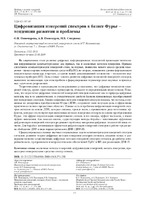| dc.contributor.author | Пономарева, О. В. | |
| dc.contributor.author | Пономарев, А. В. | |
| dc.contributor.author | Смирнова, Н. В. | |
| dc.coverage.spatial | Минск | ru |
| dc.date.accessioned | 2019-09-20T05:25:36Z | |
| dc.date.available | 2019-09-20T05:25:36Z | |
| dc.date.issued | 2019 | |
| dc.identifier.citation | Пономарева, О. В. Цифровизация измерений спектров в базисе Фурье – тенденции развития и проблемы = Digitalization of Spectral Measurements in the Fourier Basis – Development Trends and Problems / О. В. Пономарева, А. В. Пономарев, Н. В. Смирнова // Приборы и методы измерений : научно-технический журнал. – 2019. – Т. 10, № 3. – С. 271-280. | ru |
| dc.identifier.uri | https://rep.bntu.by/handle/data/57146 | |
| dc.description.abstract | На современном этапе развития цифровых информационных технологий происходит интенсивная цифровизация (компьютеризация) как прямых, так и косвенных методов измерения. Прямым следствием компьютеризации измерений стало, во-первых, появление нового класса средств измерения – процессорных измерительных средств (ПрИС); во-вторых, повышение уровня формализации измерительных процедур; в-третьих, создание новой, революционной технологии – технологии виртуальных приборов (ВП). Цель статьи – анализ развития цифровых технологий измерений спектров, выявление возникающих при этом проблем и формулирование первоочередных научных и прикладных задач по их разрешению. Теоретическими и прикладными исследованиями установлено, что цифровые технологии измерений спектра, кроме существенных преимуществ, обладают и определенными недостатками. Показано, что недостатки цифровых технологий измерений спектров вытекают как из природы цифровых методов, так и из аналитических и стохастических свойств базисов применяемых преобразований при измерениях спектров. Анализ цифровых методов измерений спектров показал, что методы, основанные на дискретном преобразовании Фурье (ДПФ), сохраняют свою ведущую роль и эффективны практически во всех предметных областях. Однако есть и проблемы цифровизации измерений спектров сигналов на основе ДПФ, которые связаны, прежде всего, с проявлением ряда негативных эффектов, которые отсутствуют при аналоговых методах измерения спектров на основе преобразования Фурье. Это эффект периодизации измерительного сигнала и его спектра, эффект частокола, а также эффект наложения. Как показал анализ, существующие методы борьбы с негативными эффектами цифровизации измерений спектров разрешают проблемы внедрения цифровых технологий лишь отчасти. Для борьбы с негативными эффектами цифровизации измерений спектров в работе предложено обобщение ДПФ в виде параметрического ДПФ (ДПФ-П). Сформулированы основные научные и прикладные задачи компьютеризации измерений спектров сигналов: развитие теории цифровых методов измерения спектров сигналов, создание новых и усовершенствование существующих цифровых методов измерений спектров сигналов, разработка алгоритмического, программного и метрологического обеспечений ПрИС и ВП для реализации ДПФ-П. | ru |
| dc.language.iso | ru | ru |
| dc.publisher | БНТУ | ru |
| dc.title | Цифровизация измерений спектров в базисе Фурье – тенденции развития и проблемы | ru |
| dc.title.alternative | Digitalization of Spectral Measurements in the Fourier Basis – Development Trends and Problems | ru |
| dc.type | Article | ru |
| dc.identifier.doi | 10.21122/2220-9506-2019-10-3-271-280 | |
| local.description.annotation | At the present stage of development of digital information technologies intensive digitalization (comp uterization) of both direct and indirect measurement methods is taking place. The direct consequence of the computerization of measurements was, firstly, the emergence of a new class of measuring instruments – Processor measuring instruments (PRIS), secondly, increasing the level of formalization of measuring procedures, thirdly, the creation of a new, revolutionary technology –Virtual Instrument (VI). The purpose of the article is to analyze the development of digital technologies for measuring spectra, identifying the problems that arise in this case and formulating priority scientific and applied problems for their resolution. Theoretical and applied research has established that digital spectrum measurement technologies, in addition to significant advantages, have certain disadvantages. It has been shown that the disadvantages of digital technologies for measuring spectra arise both from the nature of digital methods and from the analytical and stochastic properties of the bases of the applied transformations in measuring the spectra. An analysis of digital methods for measuring spectra showed that methods based on Discrete Fourier Transform (DFT) retain their leading role and are effective in almost all subject areas. However, there are also problems of digitalization of measurements of the spectra of signals based on the DFT, which are associated, first of all, with the manifestation of a number of negative effects that are absent with analog methods for measuring spectra based on the Fourier transform. This is the periodization effect of the measuring signal and its spectrum, the stockade effect, as well as the aliasing effect. As the analysis showed, existing methods of dealing with the negative effects of digitalization of spectrum measurements solve the problems of introducing digital technologies only partially. To combat the negative effects of digitalization of spectral measurements, a generalization of the DFT in the form of a parametric DFT (DFT-P) (Parametric Discrete Fourier Transform – DFT-P) is proposed. The main scientific and applied problems of computerization of signal spectrum measurements are formulated: the development of the theory of digital methods for measuring signal spectra, the creation of new and improvement of existing digital methods for measuring signal spectra, the development of algorithmic, software and metrological software for PRIS and VI for the implementation of DFT-P. | ru |

